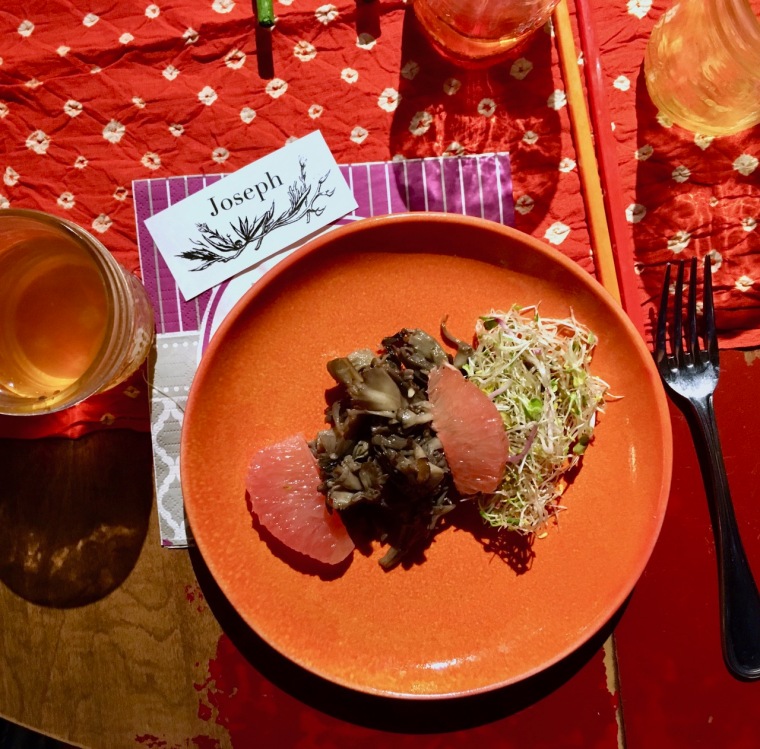by Joseph Winters ’20
At 5:57 PM, I sidled into my seat at a communal table next to Kendyl from California, who had been a vegan for four years, and Steve, who said he kept Kosher, but also called himself a flexitarian, a flexible vegetarian. A few minutes later, “Same” sat down to my right. I looked at his name tag and wondered how to pronounce such an unique, ethnic name.
“It’s Sam,” he said. “They got it wrong.”
Whoops, I thought.
Sam’s sister, Thuy, came next, and finally Krystal. The six of us were sitting around a circular table in the basement of Life Alive, a vegetarian/alternative restaurant in Central Square. Life Alive’s regular menu includes a variety of vegetable/grain bowls full of yummy sauces like “Ginger Nama Shoyu,” as well as a wraps, salads, smoothies, and juices. That night, January 25, they were having a four-course pop-up dinner crafted by “culinary guru” Leah Dubois, with each course paired by a special mushroom tea mocktail from Tamim Teas, a Cambridge-based tea company started by a Harvard graduate who had studied urban planning.
We all sat around the table a little awkwardly at first. Inevitably, the conversation turned to food—what else could have brought us all together at a gourmet vegetarian dinner? Most of us had experimented with some kind of reduced-meat diet before—Kendyl with her veganism, Sam’s “hardcore” vegetarianism (as described by his sister, Thuy), my pescatarianism (no meat, but fish and shellfish are okay), and the Kosher keepings of both Steve and Krystal.

Our conversation became more relaxed as we began to nibble on the first course: deviled eggs. But in true Life Alive fashion, they weren’t ordinary deviled eggs. Apart from being free-range eggs, the filling was made from cashew aioli and mustard, and they were topped with house-made pickled jalapeños and sprouts. There were plenty to go around, whetting our appetites for the rest of the meal.
As we munched on our eggs, we were introduced to the owner of Tamim Teas, Liat, who started drinking mushroom-infused teas for their health benefits (not the taste, which, as she writes on her website, is less than appetizing). But, as Liat later discovered, mushroom teas could be made really tasty by using local fungi and “balancing the flavors of mushrooms with a unique array of organic, caffeine-free herbs, [to make] them safe and accessible to a wider demographic.” For our first tea, we tried an astralagus-infused blend made from maitake shrooms, locally-sourced ginger and goji berries. Lost yet? So was I—astralagus is apparently a root with lots of medicinal properties, and maitakes are a kind of mushroom apparently renowned for their anti-inflammatory properties. Goji berries just taste good, I guess (plus they’re a berry, so they’ve probably got some great antioxidant properties or something). The tea was warm and soothing, and paired well with the deviled eggs.

Next we had the “Life Alive version of dahl,” Leah explained to our table. It was made with black lentils, sautéd fresh ginger, turmeric, garlic, onions, cumin seeds popped in coconut oil, and rainbow carrots from a local farm. It was topped with house-made pickled mango, cayenne pepper, cilantro, and radish sprouts. Everyone at the table loved the dahl. I’m pretty sure I overheard Steve whisper “they hit a home run with this one” into his bowl. Very soothing and mild, I really enjoyed the tang the pickled mango gave it.
Liat came by again, this time with a cold tea. It was called the Lion’s Share Blend, and had lion’s mane mushrooms, local turmeric, black peppercorns, and green rooibos. The roobois was interesting because it’s generally sold red—this is because, as Liat explained, it’s easier to sell rooibos in burned form, maybe because it has to be shipped all the way from Africa, where it is mostly grown. You’ve probably had rooibos if you’ve ever sipped on specialty herbal teas infused with fruity flavors like pineapple or mango.

Salad was next, featuring—believe it or not—more mushrooms! Maitakes made an appearance in whole form, having been roasted to delicious tenderness and finished with alfalfa and radish micro greens, citrus slices, and a lemony vinaigrette. This was really light and fruity, an interesting contrast to the soothingness of the dahl.
Liat’s tea pairing was called Shiitake Uplift, including rooibos, ginger, lemongrass, lemon peel, and a touch of kombucha for fizziness. The fizz went perfectly with the lightness of the salad, and the citrus matched the lemony dressing. This “tea” (it was more kombucha-y than tea-like) was probably my favorite, possibly because it was pretty sweet.

For dessert, Leah brought us these gorgeous mini jars full of coconut milk-based lavender gelato, speckled with crumbled pistachios and coconut flakes. The gelato was phenomenal—super creamy, coconut-y, and sweet. I’m not sure if I could tell that there was lavender in the gelato itself, but there were little pieces of whole lavender petals (if they’re called petals) between the pistachio and coconut flakes.
Our gelato was paired with Reishi Delight, apparently made from a mushroom that is one of the oldest fungi used for its medicinal purposes. It was combined with African honeybush, two types of cinnamon (one of which was in whole form), and orange peel. It was served warm and contrasted well with the cold gelato. It was especially good after Liat poured in some of Life Alive’s house-made almond milk.
According to Leah, these kinds of pop-up dinners are going to become monthly-occurring Life Alive events, possibly in partner with different local businesses like Tamim Teas.

As I polished off the last scoop of lavender gelato from the bottom of my mini Mason jar, Kendyl said goodbye to our little group of new friends. I followed soon after, leaving the others to continue their scintillating conversation about the challenges faced when home pickling watermelon rinds. I had a great experience—great food, tea, and cool people. I will definitely keep checking my Instagram for news of future Life Alive pop-ups!

